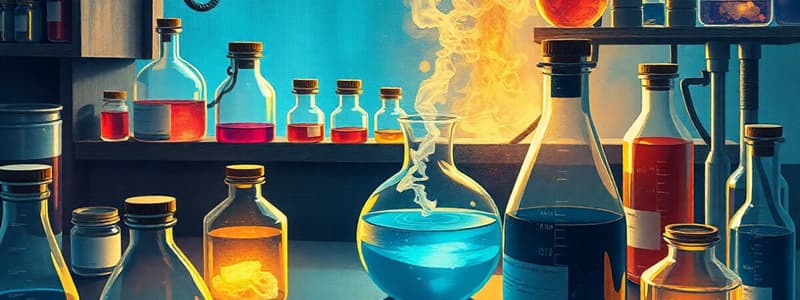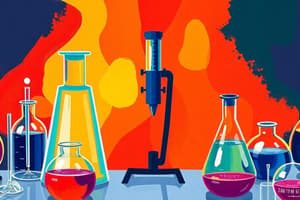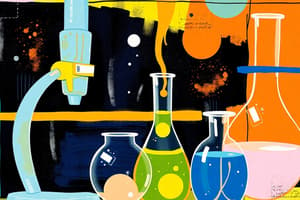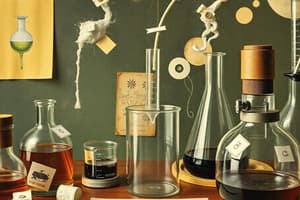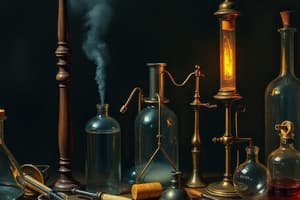Podcast
Questions and Answers
A ______ room is a controlled environment designed for scientific research, experiment, analysis, and measurement.
A ______ room is a controlled environment designed for scientific research, experiment, analysis, and measurement.
laboratory
A ______ dish is a shallow, cylindrical dish with a flat bottom, typically made of glass or plastic, used in laboratories for culturing microorganisms or cells.
A ______ dish is a shallow, cylindrical dish with a flat bottom, typically made of glass or plastic, used in laboratories for culturing microorganisms or cells.
Petri
Eukaryotes can be single-celled (e.g., protists) or ______ (e.g., animals, plants, and fungi).
Eukaryotes can be single-celled (e.g., protists) or ______ (e.g., animals, plants, and fungi).
multicellular
Before handling chemicals, always wash your hands with soap and ______.
Before handling chemicals, always wash your hands with soap and ______.
Know the location of the fire ______, fire blanket, eyewash station, and first aid kit.
Know the location of the fire ______, fire blanket, eyewash station, and first aid kit.
Prokaryotic cells have a ______ DNA structure, while eukaryotic cells have a linear DNA structure associated with histones.
Prokaryotic cells have a ______ DNA structure, while eukaryotic cells have a linear DNA structure associated with histones.
Safety signs in a lab are standardized symbols and instructions that communicate important safety ______.
Safety signs in a lab are standardized symbols and instructions that communicate important safety ______.
Prokaryotic cells are generally ______ in size compared to eukaryotic cells.
Prokaryotic cells are generally ______ in size compared to eukaryotic cells.
All living organisms can be sorted into one of two groups depending on the fundamental structure of their ______.
All living organisms can be sorted into one of two groups depending on the fundamental structure of their ______.
Prokaryotic cells lack membrane-bound organelles, while eukaryotic cells have ______ organelles.
Prokaryotic cells lack membrane-bound organelles, while eukaryotic cells have ______ organelles.
The cell wall of prokaryotic bacteria is composed of ______, while the cell wall of eukaryotic fungi is composed of chitin.
The cell wall of prokaryotic bacteria is composed of ______, while the cell wall of eukaryotic fungi is composed of chitin.
Prokaryotic cells are simple, single-celled organisms that lack a membrane-bound ______ and other organelles.
Prokaryotic cells are simple, single-celled organisms that lack a membrane-bound ______ and other organelles.
Examples of prokaryotic cells include ______ and Archaea.
Examples of prokaryotic cells include ______ and Archaea.
Eukaryotic cells are more complex cells that have a defined, membrane-bound nucleus containing their genetic material (______).
Eukaryotic cells are more complex cells that have a defined, membrane-bound nucleus containing their genetic material (______).
Microbiology is the study of microscopic organisms, either unicellular (Bacteria), ______ (fungi), or acellular (virus).
Microbiology is the study of microscopic organisms, either unicellular (Bacteria), ______ (fungi), or acellular (virus).
Bacteria can exist either as independent (free-living) organisms or as ______ (dependent on another organism for life).
Bacteria can exist either as independent (free-living) organisms or as ______ (dependent on another organism for life).
Flashcards
Eukaryotic Cells
Eukaryotic Cells
Cells that possess a nucleus and membrane-bound organelles.
Prokaryotic Cells
Prokaryotic Cells
Cells without a nucleus, typically smaller and simpler than eukaryotic cells.
Binary Fission
Binary Fission
A method of asexual reproduction in prokaryotic cells.
Mitosis
Mitosis
Signup and view all the flashcards
Bacteria
Bacteria
Signup and view all the flashcards
Coccus
Coccus
Signup and view all the flashcards
Bacillus
Bacillus
Signup and view all the flashcards
Spirochetes
Spirochetes
Signup and view all the flashcards
Laboratory Room
Laboratory Room
Signup and view all the flashcards
Preventive Measures
Preventive Measures
Signup and view all the flashcards
Safety Goggles
Safety Goggles
Signup and view all the flashcards
Prokaryotes
Prokaryotes
Signup and view all the flashcards
Eukaryotes
Eukaryotes
Signup and view all the flashcards
Nucleoid
Nucleoid
Signup and view all the flashcards
Lab Cleanup
Lab Cleanup
Signup and view all the flashcards
Lab Safety Signs
Lab Safety Signs
Signup and view all the flashcards
Study Notes
Laboratory Room
- A laboratory room is a controlled space designed for scientific research, experiments, analysis, and precise measurements.
- The room is equipped with specialized tools, instruments, and safety equipment.
- Researchers, scientists, and technicians use this controlled environment to perform experiments safely and accurately.
Laboratory Instruments
- Bunsen burner: Used for heating samples.
- Bacterial loop: Used to transfer small amounts of bacteria.
- Evaporating dish: Used to evaporate liquid samples.
- Wire brush: Used for cleaning laboratory glassware.
- Crucible and cover: Used to heat and or contain materials.
- 24-well plate: A plate with 24 individual wells, used for various experiments.
- Test-tube rack: Organised storage for test tubes.
- Mortar and pestle: Used for grinding solids.
- Lab burner: Used for heating substances.
- Forceps: Used in handling small objects or specimens, preventing contamination
- Wash bottle: Used for rinsing equipment.
- Pipet: Used for precise liquid measurements.
- Graduated cylinder: Used for measuring volume.
- Volumetric flask: Used for preparing solutions with precise volumes.
- Conical flask: Used for reactions, heating solutions and storing liquids.
- Watch glass: A flat, shallow dish used for covering beakers or evaporating small amounts of liquid.
- Funnel: Used to pour liquids into vessels with a small opening.
- Dropper: Used to dispense measured drops of liquid.
- Petri dishes: Used for growing microorganisms and experiments.
Preventative Measures in a Laboratory
- Listen to instructions: Read or listen carefully before conducting any experiment.
- Safety goggles: Always wear safety goggles to protect eyes from chemicals or potential hazards.
- Notify teacher: If any accident or spill occurs, immediately notify the teacher or supervisor.
- Wash hands: Wash hands thoroughly with soap and water after handling chemicals.
- Tie back hair: Secure your hair to avoid it getting caught in equipment or experiments.
- Avoid touching your face: Avoid touching your eyes, nose, or mouth while working.
- Roll up sleeves: Roll up sleeves to avoid contamination or accidents during experiments.
- Know emergency equipment locations: Locate and know the location of fire extinguishers, fire blankets, eyewash stations, and first-aid kits to use in case of emergencies
- Keep work area clean: Keep the work area uncluttered to avoid accidents
- Use necessary equipment: Use the equipment needed for your experiment without using unnecessary items.
- No contact lenses: Avoid wearing contact lenses during experiments.
- No eating or drinking: Do not eat or drink in the laboratory
- Clean up: Clean your lab area and return everything to its designated place to maintaining a safe environment
Safety Signs in a Laboratory
- Emergency signs: These signs show the locations of safety equipment (e.g., eye wash, shower).
- Safety signs: Show hazardous materials (e.g., radioactive substances, toxic chemicals).
- Specific protective equipment (PPE): PPE such as gloves, masks, eye protection
- No food or drink in lab: Indicates that food and drink are prohibited in the laboratory.
Microbiology
- Microbiology: The study of microscopic organisms (bacteria, fungi, viruses).
- Prokaryotes: Simple, single-celled organisms lacking a membrane-bound nucleus.
- Eukaryotes: Complex cells with a membrane-bound nucleus and other organelles.
- Bacteria: Single-celled organisms categorized by shape (coccus, bacillus, vibrio, spirillum, spirochete)
Studying That Suits You
Use AI to generate personalized quizzes and flashcards to suit your learning preferences.
